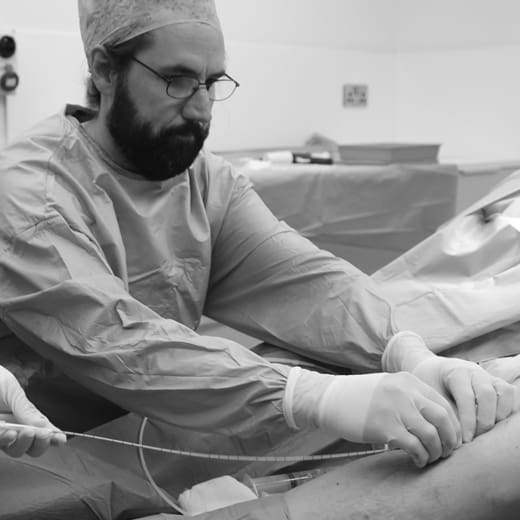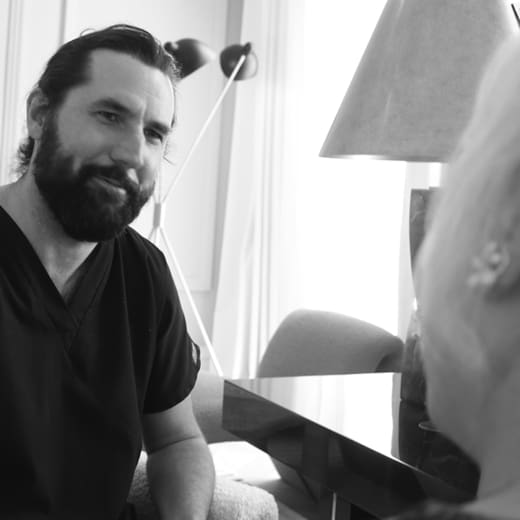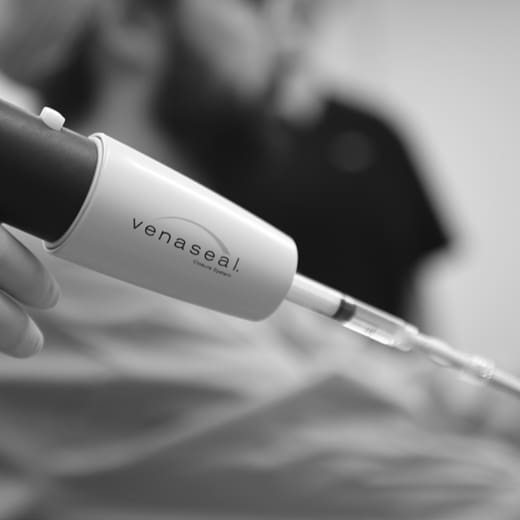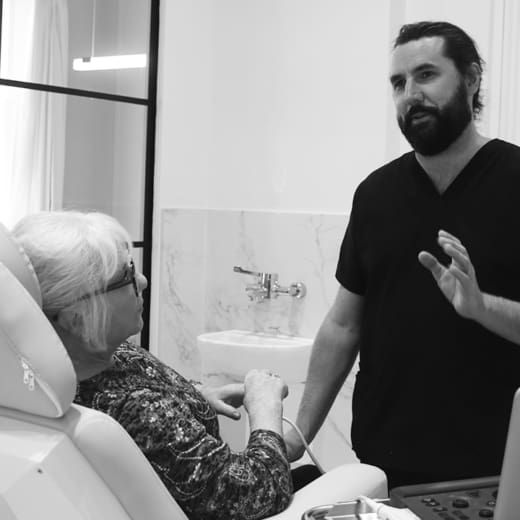McKeown Medical
167 Bath Street, Glasgow, G2 4SQ
Date posted — 2.10.24
If you’re struggling with the discomfort, swelling, or unsightly appearance of varicose veins, Radiofrequency Ablation (RFA) could be the solution you’ve been looking for. This minimally invasive procedure uses radiofrequency energy to target and close off problematic veins, providing long-lasting relief with less discomfort and downtime than traditional surgery.
In this guide, we’ll explore everything you need to know about RFA – from how it works to what you can expect during the procedure, what the recovery is, and the benefits it offers over other treatment options and the benefits some newer treatments like VenaSeal™ might have over RFA. Ultimately, there are lots of choices when it comes to treating varicose veins.

RFA is a minimally invasive medical procedure used to treat varicose veins by using radiofrequency energy to heat and close off the affected veins. It is part of a group of techniques referred to as ‘endovascular’ procedures because they involve operating inside the vein rather than outside of it in the traditional approach. RFA involves inserting a small catheter into the vein, where radiofrequency energy is delivered, causing the vein walls to contract, collapse, and eventually be absorbed by the body.
RFA was introduced in the late 1990s and early 2000s as an alternative to more invasive surgical treatments like vein stripping. Around the same time, another option known as endovenous laser ablation (EVLA) was also developed.
EVLA employs a very similar technique by delivering heat to destroy the inside of the problematic blood vessels, although it uses laser energy to deliver the heat. Both RFA and EVLA are similarly very effective, although RFA is associated with fewer side effects and is generally considered to be the superior method.
Dr Alex Vesey is our expert consultant vascular surgeon who heads up our varicose vein team. Listen to him explain the RFA treatment.

Before: Before the procedure, you’ll first have a consultation with a specialist vascular surgeon who will assess your varicose veins from taking a medical history, performing a thorough examination and an ultrasound scan to assess the anatomy of your veins. This helps determine the best veins to treat and ensures that RFA is the right option for you. On the day of the procedure, you’ll be asked to wear loose-fitting clothing and underwear that you don’t mind getting antiseptic on. You will be asked to sign an informed consent form before you go into the treatment room (a copy of this will be emailed to you in advance so you have plenty of time to read before you sign).
During: The procedure begins with the patient lying down on the treatment table and the affected leg is then cleaned and sterile drapes are applied. The doctor then makes a small incision near the knee or lower leg to insert a thin catheter into the problematic vein, guided by ultrasound imaging for precise placement. The doctor then injects a high volume of dilute anaesthetic – known as tumescent anaesthetic – along the length of the vein to be treated. As well as providing anaesthesia, this also helps to absorb the heat that is delivered to the vein during the procedure and reduces the chances of injuring surrounding tissues, like nerves. The catheter position is then rechecked and radiofrequency energy is delivered through the catheter, heating the vein walls and causing them to collapse and seal shut. This process is repeated along the length of the vein, effectively closing it off. The procedure typically takes about 30 to 60 minutes.
After: After the RFA procedure, a compression bandage or stocking is applied to the treated leg to help reduce swelling and promote healing. Most patients can stand up and walk immediately after the procedure, which is encouraged to help circulation. You may experience some discomfort, bruising, or swelling, but these symptoms usually subside within a few days. It’s generally recommended to avoid strenuous activities for about a week, but most people can return to their normal routines within a day or two. We will arrange to see you back in the clinic to assess the results, typically a few months after treatment since this is how long it takes for the veins to be reabsorbed by the body and for us to be able to assess the outcome.
Endovascular treatment with RFA offers significant benefits over traditional surgery for treating varicose veins.
One of the main advantages is its minimally invasive nature, which involves only a small incision and causes far less trauma to the surrounding tissues compared to traditional vein-stripping surgery. This leads to a quicker recovery time, allowing patients to return to their normal activities, often within a day or two, as opposed to the longer downtime required after surgery. RFA also typically results in less pain, bruising, and scarring, which improves patient satisfaction both during and after the procedure.
Additionally, because RFA uses radiofrequency energy to precisely target and close off the affected veins, it reduces the risk of complications such as nerve damage, which can be more common in traditional surgical approaches. Not everyone is suitable for RFA – which is why your initial consultation and ultrasound scan assessment are so important to make sure you get the best treatment option for your particular condition.

VenaSeal™ is a more recent innovative and effective option for the endovascular treatment of varicose veins, gaining FDA approval in 2015. VenaSeal™ uses a medical adhesive instead of heat to close off problematic veins.
The procedure involves inserting a small catheter into the vein and applying the adhesive, which bonds the vein walls together, causing the vein to seal shut and be gradually absorbed by the body. Compared to RFA, VenaSeal™ offers several advantages: it requires no heat or tumescent anaesthetic injections, which can reduce discomfort and eliminate the need for compression stockings after the procedure.
Additionally, VenaSeal™ has an even quicker recovery time – often allowing patients to resume normal activities almost immediately. While RFA remains a highly effective treatment with a proven track record, VenaSeal™ offers the same levels of effectiveness with less pain, inconvenience and downtime which is why it now accounts for around 50% of varicose vein treatment in the USA.
We are the first clinic in Scotland to introduce what is now considered to be the gold standard treatment for varicose veins.
If you’d like to find out if Radiofrequency Ablation (RFA) is the right treatment for you, the first step is to fill out our online consultation form. From there, our team will be able to arrange an initial consultation and ultrasound scan, and we can work together to create a treatment plan that is tailored to your needs.

Radiofrequency ablation (RFA) and endovenous laser ablation (EVLA) are two minimally invasive treatments used to effectively treat varicose veins, but...

When it comes to treating varicose veins, VenaSeal™ has emerged as a revolutionary option that offers a minimally invasive and...

Varicose veins are enlarged, twisted veins that often appear just under the skin, primarily in the legs and feet.
1 / 3
2 / 3
3 / 3

Radiofrequency ablation (RFA) and endovenous laser ablation (EVLA) are two minimally invasive treatments used to effectively treat varicose veins, but...

When it comes to treating varicose veins, VenaSeal™ has emerged as a revolutionary option that offers a minimally invasive and...

Varicose veins are enlarged, twisted veins that often appear just under the skin, primarily in the legs and feet.
Fine lines etched into the skin around the mouth - this is a common problem and in this patient`s case she had what we call ‘actinic elastosis’, whereby abnormal bands of elastin build up in the skin as a result of years of previous sun exposure.
When patients have this condition, the gold standard way of dealing with it is fully ablative laser resurfacing. It’s an intense treatment with two weeks of downtime afterwards, but the results are spectacular - just like in this lovely patient.
The after photo is three weeks after the treatment and you can see that the skin is still a little pink, which will continue to fade over the next few months.
The patient is already delighted with the result - what do you think?

It’s beginning to look a lot like Christmas!
At least according to Michael Buble, who’s been on repeat in the clinic this week. The decorations are up and we are officially in ‘our season’. The clinic has been packed with everyone having their skin polished in time to make it on the nice list. If you’ve still to make a pre-Christmas appointment, we’ve still got some spaces left for your festive glow up.
Ho ho ho everyone… It’s time for Santa!!!! 🎅🏻

Ok, so this is the one we’ve all been waiting for. Sofwave : the results, in our hands!!!
This is the first patient we treated with @sofwave.uk when we were assessing the machine and deciding whether or not to buy it. These are the patient`s own photos that she kept throughout the healing journey.
Now do you see why we are so excited?! 🤩
#sofwave
#sofwavemed
#SUPERB
#sofwavemedical
#sofwavejourney
#sofwaveexperience

We are now well up and running with @sofwave.uk , much to the excitement of the whole team in the clinic (we are all queuing up to get a shot!)
This is a little video of the treatment being performed, so you can see what the process is like and there is even a little early preview of the results at the end.
One of the best parts is that there is no downtime, so we can still fit it in before Christmas without worrying about redness in the party season!
What do you think?
#sofwave
#sofwavemed
#SUPERB
#sofwavemedical
#sofwavejourney
#sofwaveexperience

We`re absolutely delighted to introduce you to our lovely new doctor, Dr Sharon.
With over 30 years’ experience as a medical doctor and a decade specialising in aesthetic medicine, Dr Sharon brings exceptional skill, warmth and a deeply patient-centred approach to every treatment.
She joins us with extensive expertise in injectables, including advanced toxin and filler techniques, and will also be leading our regenerative aesthetics offering with Ameela polynucleotides and Ameela Exosomes - two of the most exciting developments in skin rejuvenation. She will also be offering Profhilo and Profhilo Structura!

We have a super exciting new addition to the clinic this week, with the launch of @sofwavemed.
Sofwave is an incredible skin tightening technology that has been around for five years now. I am never first to the queue with new devices because so many don’t deliver and disappear within a couple of years of launch. Sofwave however has continued to grow in popularity over the years and earlier this year I decided I had to find out what all the fuss was about.
I asked the reps to bring it round for us to play with and we treated a few of our patients to see what the results were like and, three months later not only was I signing the purchase order I was asking how quickly I could get one of the reps round to treat me 😊
Sofwave works using ultrasound waves to create a thermal injury to the deeper layers of the skin, initiating a healing response which over a period of several months results in a skin tightening effect.
I have trialled a number of ultrasound devices in the past and have never bought any of them because I was always disappointed in the results. There are a couple of things that I think makes Sofwave different.
First, it only goes to 1.5mm which means all of the energy is being delivered to the skin. Most other devices go down to 3 or 4mm, by which point you are past the skin and into the fat which can, if anything, have a worsening effect on volume loss. The second difference that I think is important is that it treats a bigger proportion of the surface area of the skin.
We have a new page on our website where you can read all about Sofwave and how it works, but for now, enjoy some of these before and afters that the manufacture supplied.
Let me know what you think!

Lower eyelid surgery is one of the more challenging operations in aesthetic practice. If we can avoid it, we normally try to help our patients chose non-surgical paths using laser or fillers.
However, there are some situations where it can’t be avoided, especially when there is excess fat under the eye causing puffiness. This is exactly what this patient had and so the very talented @bramhallplasticsurgery performed an upper and lower blepharoplasty for him. Whilst we often do the upper eyelids without doing the lower eyelids, usually when we do the lower eyelids we always need to do the uppers too.
This patient is now a couple of months out from surgery and loving his result. What do you think?

Laser season continues!
Thank you to this lovely patient who has kindly allowed us to share her results. She was particularly concerned about the fine lines and creases around her mouth, and underwent full-field laser resurfacing to target the deeper layers of the skin.
This is just two months after treatment and you can already see a significant improvement in the fine lines and overall skin texture. She’s still a little red and got some more healing to do, but she is already very happy with the improvement. This patient was a bit anxious about having the treatment done, so chose to have it under sedation which means she slept throughout and woke up when it was over!
What do you think?

It’s been six months since we launched the new toxin Relfydess in the clinic so, how is it going?
We’ve undertaken a survey of all of the patients we treated with the new toxin in the first month, who are now around six months since their first treatment, to find out more about what they thought of the results over the longer term - whether it kicked in faster, whether it looked better and whether they felt it lasted longer than the previous toxin.
Here are the results, and the feedback so far is really encouraging with the majority of patients reporting that it kicked in faster, looked better and lasted longer.
If you’d like to see more detail and analysis of these results, check out the link to the blog post in our profile.
